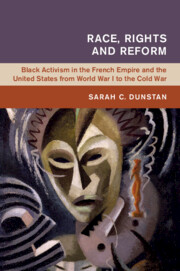 Race, Rights and Reform
Race, Rights and Reform Book contents
- Race, Rights and Reform
- Global and International History
- Race, Rights and Reform
- Copyright page
- Contents
- Acknowledgments
- Notes on Terminology and Language
- Introduction
- 1 Black Is a Country, n’est-ce pas? Race, Rights and Nation in the Wilsonian Moment
- 2 Anti-imperial Comrades: Black Radicalism and the Communist Possibility
- 3 La vogue nègre: Racial Renaissance at the Intersection of Republic, Empire and Democracy
- 4 Civilization’s Gone to Hell? Revolutionary Poetry, Humanism and the Crisis of Sovereignty
- 5 Give Me Liberty! Black Intellectual Struggles against Fascism in the Fight for Democracy
- 6 “A New Fascism, the American Brand”: Anti-communism, Anti-imperialism and the Struggle for the West
- 7 “The Sword of Damocles”: Présence Africaine and Decolonization in the Face of the Cold War
- Epilogue
- Bibliography
- Index
3 - La vogue nègre: Racial Renaissance at the Intersection of Republic, Empire and Democracy
Published online by Cambridge University Press: 01 March 2021
- Race, Rights and Reform
- Global and International History
- Race, Rights and Reform
- Copyright page
- Contents
- Acknowledgments
- Notes on Terminology and Language
- Introduction
- 1 Black Is a Country, n’est-ce pas? Race, Rights and Nation in the Wilsonian Moment
- 2 Anti-imperial Comrades: Black Radicalism and the Communist Possibility
- 3 La vogue nègre: Racial Renaissance at the Intersection of Republic, Empire and Democracy
- 4 Civilization’s Gone to Hell? Revolutionary Poetry, Humanism and the Crisis of Sovereignty
- 5 Give Me Liberty! Black Intellectual Struggles against Fascism in the Fight for Democracy
- 6 “A New Fascism, the American Brand”: Anti-communism, Anti-imperialism and the Struggle for the West
- 7 “The Sword of Damocles”: Présence Africaine and Decolonization in the Face of the Cold War
- Epilogue
- Bibliography
- Index
Summary
Chapter 3 maps out the different ways in which black activists from both the United States and France employed culture as a method of demonstrating their contributions to Western modernity and as a means of thinking through the relationship between republicanism and race. It spans from the 1925 publication of Alain Locke’s ethnographic anthology, The New Negro, through to the establishment of the anti-reformist, revolutionary journal Légitime Défense in 1932. During this period, understandings of race were framed by France’s vogue nègre of les années folles and the American negrophilia of the roaring twenties. These two phenomena had in common a fetishized representation of black men and women in the literature and anthropology of both nations. Many black thinkers such as James Weldon Johnson embraced this enthusiasm, reasoning that attention to the race and opportunities for patronage would eventually lead to greater social equality, an evolution that would theoretically enforce equality before the law. Other commentators and activists such as Jane Nardal and Alain Locke instead advocated a more inclusive understanding of what it meant to be civilized and to be human. These debates played out through journals that are rarely studied in tandem, such as Challenge, La Revue du Monde Noir, Opportunity and La Dépêche Africaine, as well as through the publications and personal correspondence of intellectuals such as Paulette and Jane Nardal, Alain Locke, Clara Shepard and René Ménil.
- Type
- Chapter
- Information
- Race, Rights and ReformBlack Activism in the French Empire and the United States from World War I to the Cold War, pp. 86 - 113Publisher: Cambridge University PressPrint publication year: 2021


